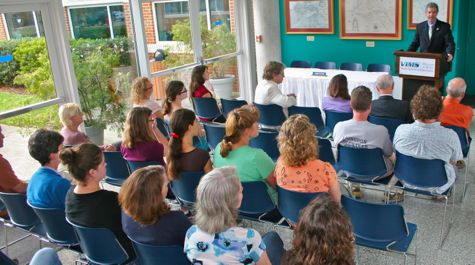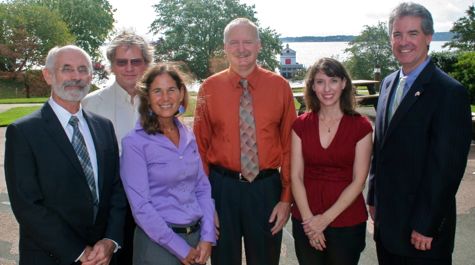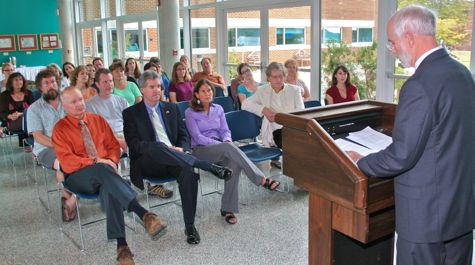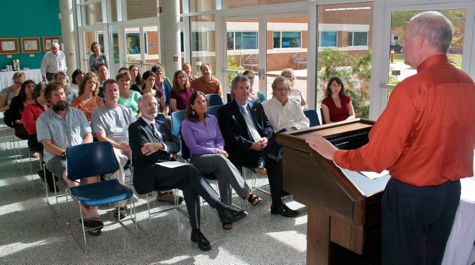VIMS will use major EPA grant to help protect Chesapeake Bay
New tools will help localities throughout Virginia maintain headwater wetlands
Every day throughout Chesapeake Bay’s 64,000-square-mile watershed, city and county officials make land-use decisions—approval of a new subdivision, siting of a retention pond, preservation of a green space—that ultimately impact the Bay through their effects on the headwater wetlands that provide a first-line of defense for Bay water quality.
Now, a 3-year, $999,640 grant from the U.S. Environmental Protection Agency to the Virginia Institute of Marine Science will allow VIMS researchers to develop planning tools that will help local governments and citizens more effectively and efficiently protect the upland swamps and swales that keep pollutants and excess nutrients from entering Bay tributaries.
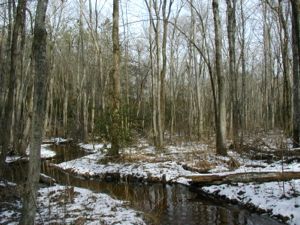 The grant was announced on October 2nd during an EPA press conference on VIMS’ main campus in Gloucester Point. During his formal presentation of the award, EPA Regional Administrator Shawn M. Garvin said, "Through this grant, VIMS will work to reduce wetland loss in Virginia, which will help the state's economy as well as its environment.”
The grant was announced on October 2nd during an EPA press conference on VIMS’ main campus in Gloucester Point. During his formal presentation of the award, EPA Regional Administrator Shawn M. Garvin said, "Through this grant, VIMS will work to reduce wetland loss in Virginia, which will help the state's economy as well as its environment.”
“Wetlands play a powerful role in our environment,” said Garvin. “They are often called nature's kidney for their ability to remove excess nutrients, toxic substances, and sediment from water that flows through them, helping to improve downstream water quality.”
Leading the EPA project is Dr. Carl Hershner, Director of the Center for Coastal Resources Management at VIMS. “Virginia has already lost half its wetlands,” he says, ”and, despite current efforts, continues to lose wetlands and the ecosystem services they provide, including wildlife habitat, flood control, and water filtration. The EPA grant will help us develop resource-management plans that provide guidance and tools for protecting wetlands in light of existing land use and development pressures. Our goal is to deliver planning tools that are specific to localities throughout Virginia, to meet the everyday needs of planners, regulators, and citizens.”
The project will expand on VIMS’ previous contributions to Virginia’s EPA-approved Wetland Program Plan, and supports the broader U.S. policy of “no net loss” of wetlands, first implemented by President George H.W. Bush in 1988. Ultimately, protection and regulation of the nation’s wetlands is mandated under the Clean Water Act of 1972.
Hershner notes that during the last decade, the focus of “no-net-loss” has shifted from preserving wetland acreage to preserving the ecosystem services that wetlands provide. “It does little good to replace a natural 10-acre wetland with a created 10-acre wetland if the latter doesn’t provide filtration, erosion protection, or habitat,” he says. “Those ecosystem services enhance the quality of life for all Virginians, and contribute millions of dollars to the state economy each year.”
Hershner will collaborate on the project with Dr. Kirk Havens, Assistant Director of the Center for Coastal Resources Management; Ms. Marcia Berman, manager of VIMS’ Comprehensive Coastal Inventory; and Dr. Donna Bilkovic, a research assistant professor in VIMS’ Coastal Watershed program.
VIMS Dean and Director John Wells says “Carl and his colleagues in CCRM have an exceptional record of translating research-based knowledge into web-based tools that resource managers can use to make informed decisions concerning sustainable use of the Commonwealth’s natural resources. This grant will allow them to customize those tools for use in the headwaters areas that play such an important role in keeping pollution out of the Bay.”
Previous research shows that headwater wetlands—by intercepting and modifying runoff and groundwater before it can enter the Bay’s tributary streams—are particularly important for protecting Bay water quality, and that protecting them will benefit water quality proportionately more than preservation of wetlands further downstream.
Hershner’s team will use the EPA grant to address three key elements of Virginia’s current wetlands plan. Their work will build off similar tools they’ve created for managing tidal wetlands, and leverage a treasure trove of geographic data they’ve collected and interpreted during the last two decades.
Results from one of the team’s previous mapping projects— a 2003 collaboration between VIMS and the U.S. Fish and Wildlife Service’s National Wetlands Inventory Program—indicate the scope of their planned undertaking. The 2003 effort tallied approximately 515,536 acres of headwater wetlands in Virginia, about 43% of all vegetated wetlands in the Commonwealth. These streamside wetlands filter the water entering all of Chesapeake Bay's tributaries and feeder streams in Virginia, including the Appomattox, James, York, Rappahannock, and Potomac rivers.
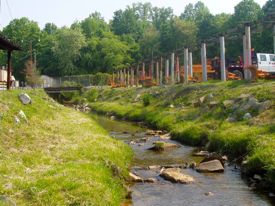 Havens says, “We’ll revise our existing monitoring and assessment strategy to make it easier for planners and managers to gauge how proposed changes in land use will affect the ecosystem services that headwater wetlands provide, with a particular emphasis on their role in maintaining water quality.”
Havens says, “We’ll revise our existing monitoring and assessment strategy to make it easier for planners and managers to gauge how proposed changes in land use will affect the ecosystem services that headwater wetlands provide, with a particular emphasis on their role in maintaining water quality.”
“We’ll also enhance community resource management plans to include tools for assessing risk, defining restoration goals, and gauging the scope of ecosystem services in headwater wetlands,” says Havens. “We’ll develop new outreach strategies to target local government decision-makers as the group most directly affecting headwater resources.”
Finally, he says, “We’ll also develop a new web-based tool that will extend our current Wetlands Data Viewer, making it easier for planners and managers to incorporate information useful in planning wetland protection and mitigating wetland impacts.”
VIMS will pursue the project in cooperation with state managers and with the advice of federal regulators. The ultimate goal, says Hershner, “is to have the tools we create facilitate coordination across all levels of government.”

